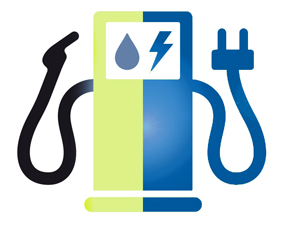Falling Gas Prices Put Red Light On Sales Of "Green" Vehicles

Last month, Americans bought over 13,000 plug-in and battery powered hybrid vehicles. But "gas guzzlers" have been selling just as well. The moral of the story? It's hard to convince people hybrids are a good idea when gas is under $2 per gallon.
Fiat Chrysler unveiled its first hybrid minivan, the Pacifica at Detroit's North American International Auto Show. IMPCO Automotive is now offering a 5.0 liter Bi-Fuel version of the Ford F-150 that runs on compressed natural gas (a conversion can be purchased at Ford commercial dealerships with a ship-through option through IMPCO's Indiana Conversion Center). So it's clear that automakers are trying to overcome the stereotype of what a hybrid is supposed to be. Their aim is to get consumers excited about the idea of driving a vehicle that is good on gas and good for the planet that isn't shaped like a doorstop.
But despite these efforts, sales of hybrid vehicles are still sluggish in both the U.S. and Canada. In 2015, Canadians saw sales of crossover vehicles overtake compact cars sales for the first time.
Jay Baron, President of the Center for Automotive Research in Ann Arbor, MI, said that there is "a huge disconnect" between the consumer and the auto industry. As a rule, Baron says drivers "are not concerned about gas prices and they are not demanding these [new] technologies." To his point, a recent JD Power and Associates survey found that fuel economy ranks third with prospective car buyers behind exterior styling and comfortable seating.
But despite this poll, cars and trucks are still required to meet U.S. government standards for fuel economy. By 2025, these regulations will require automakers to sell vehicles that have an average fuel economy of 54.5 miles per gallon. California will have also require 15 percent of auto maker's fleets to consist of zero-emission vehicles by 2025.
 Last month, Americans bought over 13,000 plug-in and battery powered hybrid vehicles. But "gas guzzlers" have been selling just as well. The moral of the story? It's hard to convince people hybrids are a good idea when gas is under $2 per gallon.
Last month, Americans bought over 13,000 plug-in and battery powered hybrid vehicles. But "gas guzzlers" have been selling just as well. The moral of the story? It's hard to convince people hybrids are a good idea when gas is under $2 per gallon. Last month, Americans bought over 13,000 plug-in and battery powered hybrid vehicles. But "gas guzzlers" have been selling just as well. The moral of the story? It's hard to convince people hybrids are a good idea when gas is under $2 per gallon.
Last month, Americans bought over 13,000 plug-in and battery powered hybrid vehicles. But "gas guzzlers" have been selling just as well. The moral of the story? It's hard to convince people hybrids are a good idea when gas is under $2 per gallon.